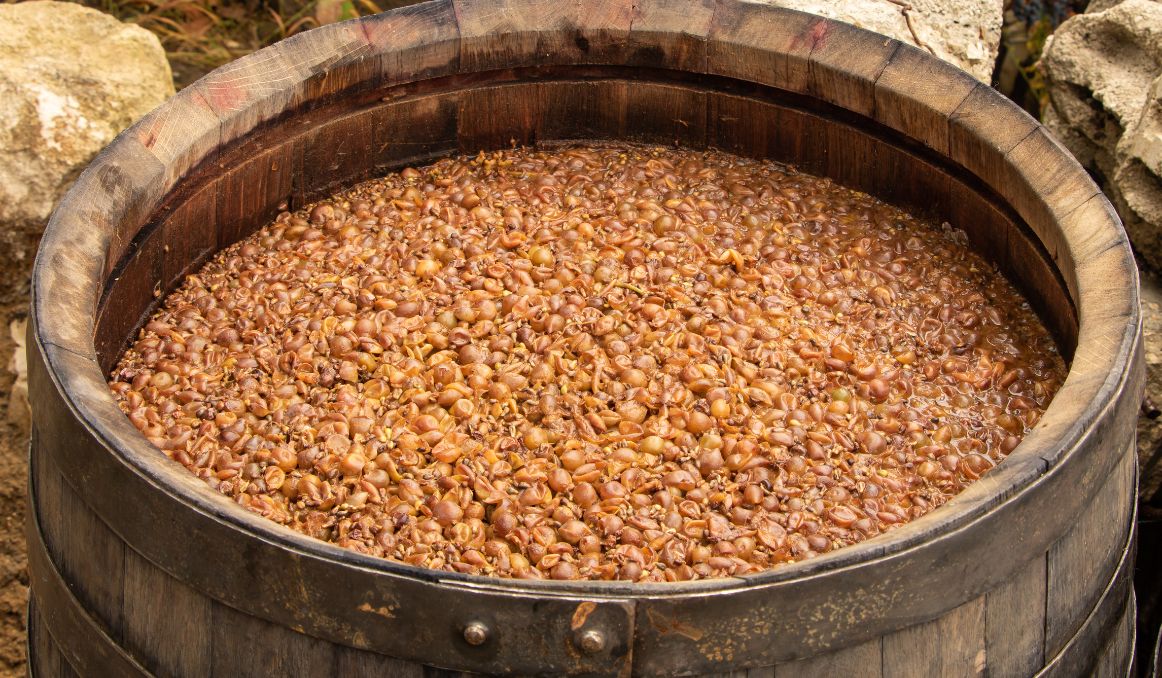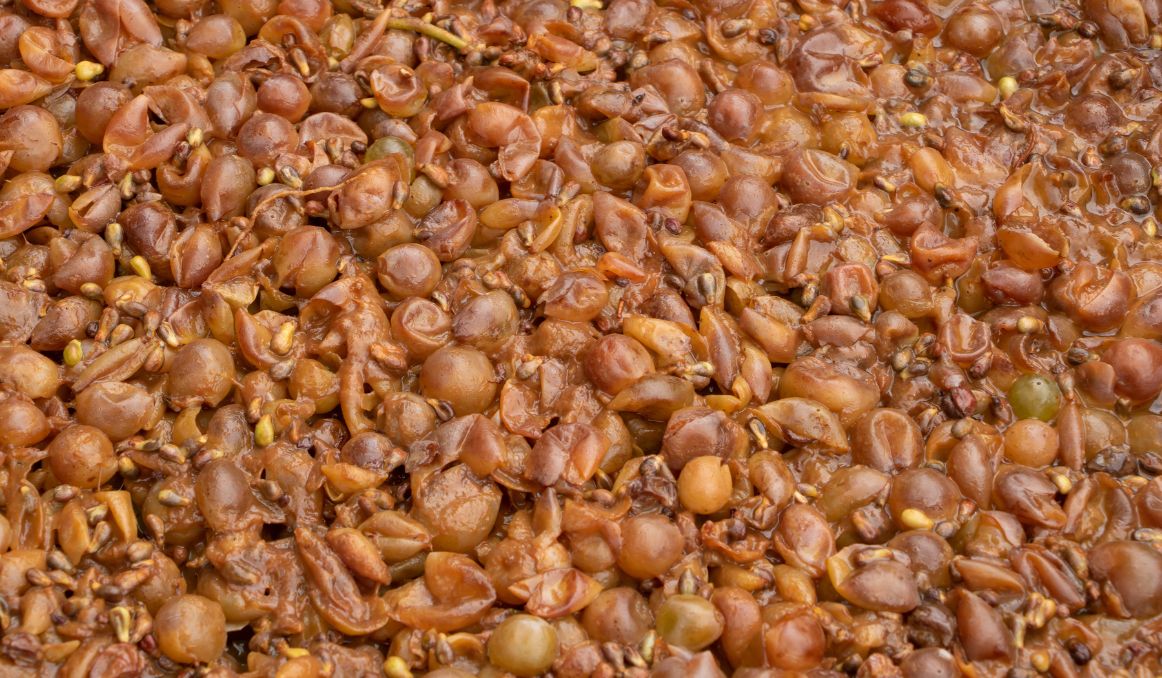Skin Contact Wine: Meaning
If you’ve been hearing about skin contact wine, which has also been called orange wine or amber wine, you’re probably wondering about the skin contact wine meaning. What is it, anyway?
Is it made with oranges? What makes it different from white wine or red wine, or even rosé?
What Is Skin Contact Wine?

Skin contact wine is quite simple: white wine that has allowed the grape skins to sit in the must for weeks or even months during maceration.
It is interesting that we call this wine skin contact wine because technically all red wines are skin contact wines. Rosé, too, is a form of skin contact wine. But I suppose we take that for granted, whereas we take for granted that white wine is not made in this way.
So we take a wine that typically does not allow the white grape skins to sit in the must, and we instead allow the wine to make contact with those skins, flipping the typical production on its head, and now we call it skin contact wine.
Seems logical, right?
How Is Skin Contact Wine Made?
Traditional white wine is made in the same way as red wine with one exception.
To make red wine, red grapes are grown and harvested, crushed and macerated (the stems, seeds, and leaves are left in the must), and fermented, racked, aged, and bottled, with a few variations for secondary fermentation and racking.
There are also adjustments made like disgorgement and dosing for sparkling wines.
The only difference with white wine is the maceration step.
At first, it seems this difference was to clearly separate white wine from red wine.
Because white wine can be made from either red grapes or white grapes, the key to making this light-colored wine has always been to separate the skins from the must immediately after crushing out the juice.
This immediate removal results in not just a light-colored wine, but also a lighter flavor that calls for cooler temperatures and lighter pairings.
Breaking from tradition then was a bold move.
To make skin contact wine, wine makers would use white grapes only and then allow the skins, seeds, and stems to sit in the must for weeks or even months, producing a wide range of colors from dark yellow to orange and even dark amber.
Thus, the nicknames “orange wine” and “amber wine” have stuck.
And no, no oranges are used in the production of skin contact wine. It is a kind of misnomer for the wine as skin contact wine is not strictly orange.
History of Skin Contact Wine
The technique of making skin contact wine is said to have originated in the country of Georgia, in Eastern Europe, thousands of years ago. Indeed, Eastern European countries have lately been calling for recognition of the fact that wine making existed in these regions long before it ever did in Western Europe.
It makes sense when you think about it as those regions were populated by entire civilizations of people with a long history long before Western Europe was discovered and developed.
In Georgia, the preferred term for skin contact wine is “amber wine,” which at least makes more sense than “orange wine” as the color amber can translate to a wider range of hues than can the color orange.
The traditional method of making skin contact wine in Georgia is to allow the indigenous white grapes ferment in their skins in clay vessels called “quevri.” This approach is a bit of a harkening to the ancient discovery of wine in the first place.
The thinking goes that a farmer stored grapes in a vessel and the juice that was naturally crushed at the bottom of the vessel would have fermented and produced the first wine known to humans.
From Georgia, the practice moved across Europe and was taken up by wine makers in northern Italy in the early 1900s, and from there across the world.
Benefits of Skin Contact Wine
Aside from its relative novelty on the modern wine market in terms of something new to try, skin contact wines have benefits we can claim when choosing one of these varietals.
Bigger, Bolder Wine
Any time a wine has been allowed to ferment with its skins, stems, and seeds, we are going to get a bigger, bolder wine with stronger body and more flavor in addition to a complexity of flavors and aromas.
So, with skin contact wines we are now able to explore the range of fermented white grapes in the same ways we do with red wines.
Polyphenols
Furthermore, all of the health benefits we tout with wine typically refer to red wine specifically because of the maceration process. Essentially, all the nutrients come from the skins and stems, so the longer they are allowed to make contact with the must, the better.
The same holds true then for skin contact wines. As the skins, stems, and seeds are allowed to sit in the must longer, we get those same benefits as we will in white wine – extra polyphenols, namely resveratrol.
Resveratrol is a phenolic compound that acts like an antioxidant and is what makes wine good for our hearts and our brains, keeping us young and healthy.
Skin Contact Wines to Try
To get you started exploring skin contact wines, you can try:
Biokult 2019 Naken, which is made with organic white grapes, is pink hued, and tastes citrusy.
Good Intentions 2018 Gris Diddly Dee Pinot Gris, which is a skin contact white that looks and tastes like a rosé.
Reyneke 2018 Reserve Biodynamic Sauvignon Blanc, which is at once rich and delicate and tastes of apples and pears.
Fritsch 2021 Zeit Orange Gruner Veltliner, which lands on the savory side of the palate.
It is up to wine makers and wine lovers alike to explore the full range of skin contact wines and decide for yourself what you prefer, and what you hope to make!
Cheers!
Passionate about the wine and/or beer making process? So are we! If you’re interested in finding out how you can use our technology to control fermentation and monitor your yeast, save work hours and improve the cost-efficiency of your business, drop us a line at [email protected] or check out our product pages:
- Oculyze FW (Fermentation Wine) Yeast Cell Counter App + Hardware
- Oculyze BB 2.0 (Better Brewing) Yeast Cell Counter App + Hardware
Also, you can now get access to a fully functional demo account to test your yeast via our Web App. Completely free of charge and with no commitment to purchase.
Sources:



